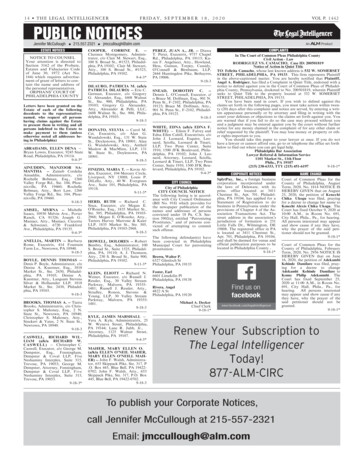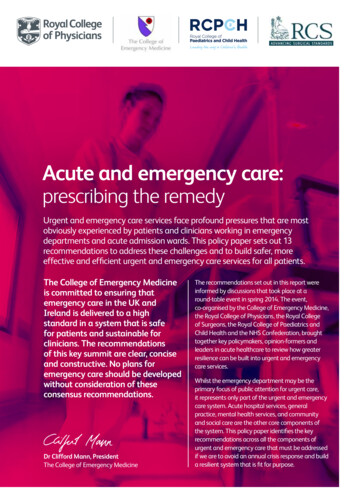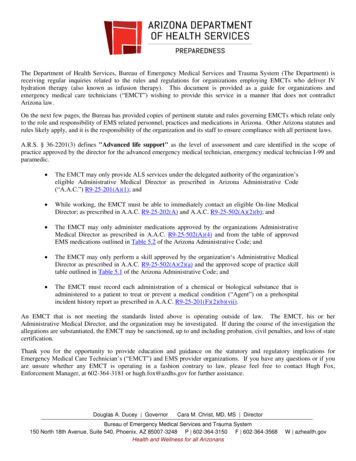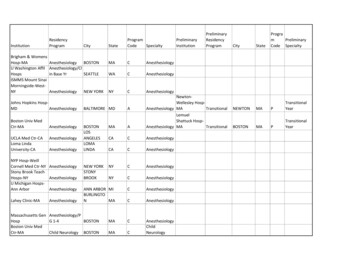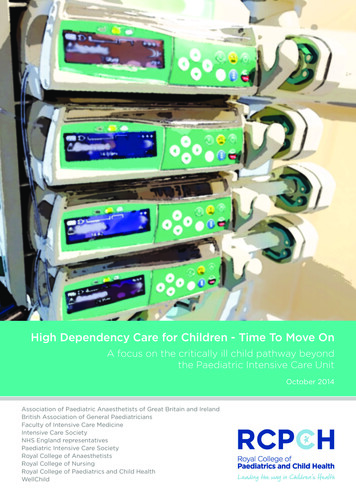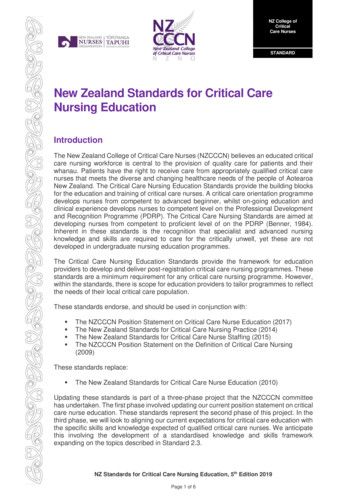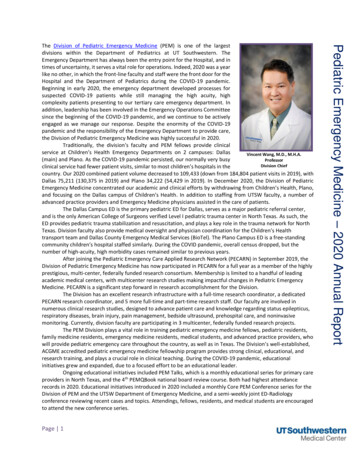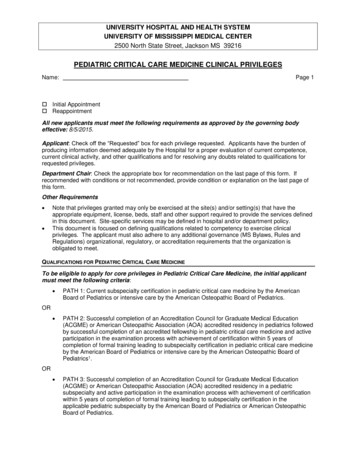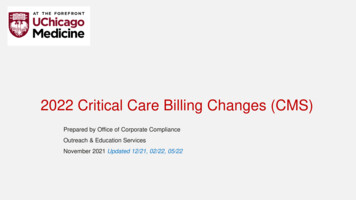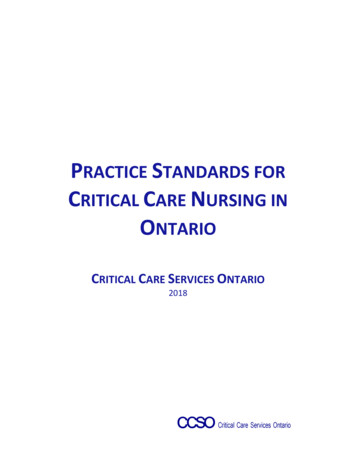![Emergency Medicine And Critical Care [Read-Only] - NAMAS](/img/66/emergency-medicine-and-critical-care-handout.jpg)
Transcription
EMERGENCY MEDICINE ANDCRITICAL CARE DEFININGTHE DIFFERENCEPresented by:ySara San Pedro CPC, CEMC, CPMA, CCP-P;AHIMA Approved ICD-10 Trainer andAmbassadorSenior Consultant for Doctors Management andNAMAS instructor
Objectives Definition of Emergency Services(99281 99285)(99281-99285) Definition of Critical CareServices (99291 & 99292) Split/SharedS lit/Shd andd TTeachinghiPhysicianso Emergency Visito Critical Care Medical Necessityo Documentation needso Care vs. location Coding Cases
CPT 99281‐99281‐99285 Accordingg to CPT,, an Emergencygy departmentpisdefined as “an organized hospital-based facility forthe provision of unscheduled episodic services topatients who present for immediate medicalattention” Must be open 24 hours a day Time does not apply No distinction between new and established May be billed as split/shared services
CPT Clinical Examples AppendixppC of the CPT Manual offers some clinicalexamples of typical encounter types that supporteach level of service CPT 99285o ED visit for a patient with active, upper gastrointestinalbleedingo ED visit for a patient with a sudden onset of “the worstheadache of their life”, stiff neck, nausea and inability toconcentrateo ED visit for an acute febrile illness in an adult, associatedwith shortness of breath and altered level of consciousness
Split Shared/ED services Physicianymust document their face-to-face pportionof the encountero May be billed by either the MD or NPPo No face-to-faceface to face by MD,MD must be billed with NPP’sNPP s NPInumbero The NPP and the MD must clearly identify themselves in therecordo Physician must document one or more elements of theencounter (history, exam and medical decision making)o “Seen“Sandd agree”” or “agree“withith above”b” are examplesl offdocumentation that would not qualifyo “Incident-to” is not reportable in the hospital setting(i(inpatientti t or outpatient)t ti t) whichhi h includesi l d theth EmergencyEDepartment
Teaching visits in the ED Care provided by interns,residents and fellowso Per Transmittal 1780 “an individualwho participates in an approvedgraduate medical educationgprogram or a physician who is notin an approved GME programbut who is authorized to practiceonly in a hospital setting”o Medical student is neverconsidered to be an intern orresident and no serviceperformed by them qualifies asbillable to Medicare
Teaching visits in the ED Three scenarios:o Teaching physician performs anddocuments all requirements of theE/M serviceo Resident performs the elements ofthe E/M and provides thedocumentation; Teachingphysicianpydocuments theirpresence and involvement in themanagemento Resident performs the E/M serviceand documents their work;Teaching physician independentlyperforms the E/M service anddocuments the work
Teaching visits in the ED Services may be reported in the following situations:o Personallyy byy a teachinggpphysicianywho is not a residento By a resident seeing a patient in the “physical presence” ofa teaching physician who documents their presenceduringg the keyy portionpof the serviceo Jointly by a teaching physician and resident, seeingpatients at a different time during a visit – physician mustperform keypypportions of the service and documentingg theirinvolvemento Resident admits the patient late at night and teachingphysicianpyevaluates the ppatient later ((includingg the nextcalendar day) Code must be reported with modifiero GC - This service has been performed in part by a residentunder the direction of a teaching physician.
CPT 99291 & 99292 CPT definition “direct deliveryy byyapphysician(s)y( ) orother qualified health care professional of medicalcare for a critically ill or critically injured patient”o Critical Illness/injury:j y One that acutelyy impairspone or morevital organ systems such that there is a high probability ofimminent or life threatenting deterioration in the patient’sconditiono 99291 – 30 tto 74 minutesi to 99292 – each additional 30 minutes CMS adds that “the failure to initiate theseinterventions on an urgent basis would likely result insudden, clinically significant or life threateningdeterioration in the patient’s condition”
CPT 99291 & 99292 High complexity medical decision making to““assess,manipulatei l t andd supportt vitalit l systemtfunction(s) to treat single or multiple vital organsystemyfailure and/or pprevent further life threateninggdeterioration of the patient’s condition.” Examples of system failure:oooooooCentralCt l nervous systemtfailuref ilCirculatory failureShockRenal failureHepatic failureMetabolic failureRespiratory failure
CPT 99291 & 99292Services included in Critical Care: the interpretation of cardiac output measurements (CPT93561, 93562)pulse oximetry (CPT 94760, 94761, 94762)chest x-rays,y pprofessional componentp((CPT 71010, 71015,71020)blood gases, and information data stored in computers (e.g.,ECGs, blood ppressures, hematologicg data-CPT 99090))gastric intubation (CPT 43752, 91105)transcutaneous pacing (CPT 92953)ventilator management (CPT 94002-94004,94002 94004 9466094660, 94662)peripheral vascular access procedures (CPT 36000, 36410,36415, 36591, 36600)
CPT 99291 & 99292Separately reportable from Critical Care: CPR (92950) (while being performed)Endotracheal intubation (31500)Central line placement (36555, 36556)I tIntraosseousplacementlt (36680)Tube thoracostomy (32551)Temporary transvenous pacemaker (33210)Electrocardiogram - routine ECG with at least 12 leads;interpretation and report only (93010)Elective electrical cardioversion (92960)()
CPT 99291 & 99292 NOT meetingg medical necessity:yo Services that do not meet critical care service definitiono Services provided for a patient who is not critically ill orinjuredo Patients located in the critical care, intensive care orspecialized care unit but did not receive critical careservices based on the definition and criteriao Must be both the treatment of vital organ failure ANDprevention of further life threatening deteriorationo Report with another appropriate E/M code Subsequent Hospital care (99231-99233) Outpatient Office visit (99201-99215) Emergency Services (99281-99285)
CPT Clinical Examples Clinical Examplespof Critical Care from AppendixppCof the CPT Manualo 13 year old with hypovolemic shock secondary to diarrheaand dehydrationo Patient who sustained a liver laceration, cerebralhematoma, flailed chest, and pulmonary contusion afterbeing struck by an automobileo Patient with septic shock following relief of ureteralobstruction by a stoneo Female who,who following a hysterectomyhysterectomy, suffered a cardiacarrest with pulmonary embolus
ED and Critical Care According to Medicare, Emergency Departmentservice codes and Critical Care service codes cannot be reported on the same day by the sameprovider.o This includes physicians of the same specialty in the samegroupo Many commercial payers will also denyo CMS Transmittal 1548 Pediatric patients (under 24 months) report codeso 99466 and 99467 Pediatric critical care interfacility transportsupervisionpo 99485 and 99486
Documentation To support critical care there must bedocumentation of:o The time spent performing CC serviceso The “unbundled” associated procedures and the amountof time performing themo A summary of the critical illness and interventions Concern of imminent organ failureo Providers should indicate what patient was at risk for Guidelines state “both the illness or injury and thetreatment must meet CC requirementsrequirements” ED providers should document time in and time outo Treat multiplep ppatients at the same time
Split/Shared Critical Care Services Split/Shared cannot bereported for critical care Each critical care codemust represent theevaluation, treatmentand management of thepatient by an individualprovider
NPP and Critical Care Nurse Practitioners andPhysician Assistants may billcritical care with their ownNational Provider Identifier(NPI) Services must be undertheir scope of practiceand licensure services forthe state where theservices are performed Medicare ClaimsProcessing Manual (Pg. 68)
Same Group Critical Care Services Same type of practitioner (physician or NPP) in thesame groupo Combine time for a group total to be billed for thecalendar dayo Example: ED physician #1 critical care time of 40 minutes,later same day ED physician #2 critical care time of 55minutes Total criticaliicare billediffor group ffor the day iis 95minuteso Cannot use combined time to meet the first unit of criticalcare. Eachh providerid mustt separatelyt l meett theth minimumi i30minute requirements (Medicare Claims Processing Manual,pg 73)
Teaching Physician and Critical Care Time spent by a resident, in absence ofthe teaching physician cannot be billedby the teaching physicianpteachingg mayy not be counted Time spenttowards critical care time Time spent by the resident and teachingphysician together with the patient OR theteaching physician alone with the patientcan be counted for time based codessuch as critical care
What to look for Highg level E/M/ services in the ED require:qo Comprehensive history and exams with moderate or highmedical decision making (99284 vs. 99285) Unable to get a history due to acute illness/injury astatement it was unobtainable supports comprehensivehistory Any portion of documentation not captured (history,(historyexam and decision making) will make the code invalid Critical Care codes:o A patientti t may beb criticallyiti ll ill or iin a criticaliti l care unitit bbuttdoes not automatically support critical care codeso Management and time are factors too
What to look for
Critical Care crosses midnight Critical Care that crossesmidnight and meet the 30minute thresholdo Report 99291o DOS is calendar date whenface-to-face visit began Non-continuous critical careperformed after midnight.CPT 99291 is reported for thenew 30 minutes on the nextDOS.
Not necessarily Critical Care Dailyy Vent Managementg Management of dialysis/care related to dialysis forESRD patient receiving hemodialysis Patient admitted to CCU when no other beds areavailable Patient admitted to ICU for observation andmonitoring vitals Patient admitted to ICU due to hospital rulesrequiring the needed treatments for the patientmust be performed in a critical care setting
Possible Critical Care Some diagnosesgmayy be routine in the ED butdepending on the interventions and timedocumented could support critical care codingooooElderly patient with acute congestive heart failurePatients with new onset of uncontrolled atrial fibrillationExtended management of severe asthma exacerbationIndividuals with supraventricular tachycardia There must be an indication of acute interventionsto prevent lifelife-threateningthreatening deterioration of thepatient’s condition Provider must document the complexity to supportcritical care
Documentation counts Provider evaluates and treats a ppatient in theEmergency Department and performs critical careinterventions totaling 20 minutes HistoryHi tiis comprehensive,hiExamEiis expandedd d anddMDM is high Critical Care is not met due to services being lessthen 30 minutes Emergency Department services require all 3 of 3elementslt ffor a coded assignmentit Time is not a factor of codes 99281-99282 Code supported would be 99283
Coding Case #1Patient was seen in the Emergency Room at 22:35 byED doctor in with severe chest pain and difficultybreathing. A comprehensive history and examinationand EKG tests were performed. IV medications wereadministered and patient was stabilizedstabilized. Patient wasobserved in the ED pending assessment for admission.ED doctor attends to other patients and receivesnotice that the patient decompensated and lossconsciousness at 00:43. ED doctor returns to thepatient and CPR is initiated and ET tube is placed.ED provider documents 105 minutes of critical care forthe first intervention and 90 minutes of critical careminus procedures.
Coding Case #1Which codes supportppthis case? 99291 and 99291-25, 31600 & 92950 99285 and 99291-25, 31600 & 92950 99291-25, 99292 , 31600 & 92950 99285-25, 31600 & 92950 99285 and 99291-25,99291 25 31600 & 92950
Coding Case #2An elderly patient with a history of seizure disorder andhistory of stroke was found unresponsive with snoringrespirations. Patient does not respond to painful stimuli.There was no other information available from the nursinghome or family. Provider documents that history wasunobtainablebt i bl ddue tto unresponsiveness.iCComprehensivehiexam was documented. EKG, Chest x-ray and CBC wereperformed. Chest x-ray was independently viewed by meshowing no infiltratesinfiltrates. Patient developed generalizedseizure activity and received Ativan and Dilantin IV. Seizureactivity ceased. Patient was still unresponsive andCardizem was administered. Heart rate dropped andpatient remained in Afib. Blood pressure was stabilized andthe patient was admitted. 85 minutes of critical care wasdocumented excluding procedures.
Coding Case #2Which codes support the case? 99291 99285 and 71010-26 9928599285 99291 and 99292, 71010-26 99291
Coding Case #3Patient presents to the ED following a gunshot wound tothe chest. Upon arrival to the ED initial resuscitation andcomplex decision making, including imaging studies,coordination with specialists for emergency surgery andcommunication with family. Patient is unable to provideany historyhi twhichhi h was ddocumented.t d A 7 organ systemtexam was performed including constitutional, a detailedrespiratory exam, detailed cardiovascular exam,gastrointestinal skin neurologic and musculoskeletal.gastrointestinal,musculoskeletal CPRwas performed, a central line and chest tube were placedand the patient was stabilized prior to transfer to theoperating room.115 minutes of critical care time was documented and 45minutes of that was spent performing procedures
Coding Case #3Which codes support this case? 99291-25, 99292, 36556, 92950 & 32551 99291, 99292 99285,99285 36556,36556 92950 & 32551 99291-25, 36556, 92950 & 32551 99291-25, 36556, 92950 & 32551
ThThanksk FFor PParticipatingti i tiSara San Pedro, CPC, CPMA, CEMCAHIMA Approved ICD-10 Trainer andAmbassadorSSeniori CConsultantlt t fforDoctorsManagement LLC andNAMAS instructorQuestions:ssanpedro@drsmgmt.com
EMERGENCY MEDICINE AND . Appendix C of the CPT Manual offers some clinical examples of typical encounter types that support each level of service CPT 99285 . peripheral vascular access procedures (CPT 36000, 36410, 36415, 36591, 36600) CPT 99291 & 99292

